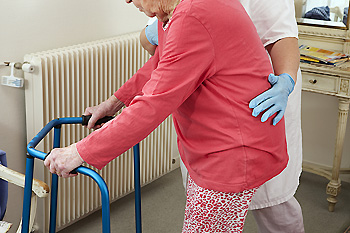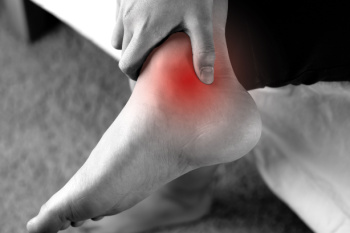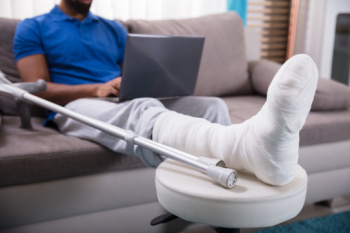Items filtered by date: September 2025
Common Musculoskeletal Issues Associated With Zumba

Zumba is a lively and enjoyable way to stay active, but its fast movements and repetitive steps can sometimes lead to musculoskeletal injuries. The feet and ankles are especially at risk since they absorb the impact of jumps, pivots, and quick turns. Common injuries include sprained ankles, heel pain from plantar fasciitis, and stress on the Achilles tendon. The knees may also be affected when improper shoes or surfaces are used. Wearing supportive footwear designed for dance or cross training can reduce the risk of injury by providing stability and cushioning. Warming up before class and incorporating stretching exercises afterward are equally important. Listening to your body and pacing yourself can help prevent overuse. If you develop foot or ankle pain or swelling during Zumba, it is suggested that you schedule an appointment with a podiatrist for a proper evaluation and appropriate care.
Ankle and foot injuries are common among athletes and in many sports. They can be caused by several problems and may be potentially serious. If you are feeling pain or think you were injured in a sporting event or when exercising, consult with Arnold Farbstein, DPM from Texas. Our doctor will assess your condition and provide you with quality foot and ankle treatment.
Common Injuries
The most common injuries that occur in sporting activities include:
- Achilles Tendonitis
- Achilles Tendon Rupture
- Ankle Sprains
- Broken Foot
- Plantar Fasciitis
- Stress Fractures
- Turf Toe
Symptoms
Symptoms vary depending upon the injury and in some cases, there may be no symptoms at all. However, in most cases, some form of symptom is experienced. Pain, aching, burning, bruising, tenderness, tightness or stiffness, sensation loss, difficulty moving, and swelling are the most common symptoms.
Treatment
Just as symptoms vary depending upon the injury, so do treatment options. A common treatment method is known as the RICE method. This method involves rest, applying ice, compression and elevating the afflicted foot or ankle. If the injury appears to be more serious, surgery might be required, such as arthroscopic or reconstructive surgery. Lastly, rehabilitation or therapy might be needed to gain full functionality in the afflicted area. Any discomfort experienced by an athlete must be evaluated by a licensed, reputable medical professional.
If you have any questions please contact our office located in Houston, TX . We offer the newest diagnostic and treatment technologies for all your foot and ankle needs.
Falling May Affect the Feet
 Many people have a difficult time recovering from falls that have occurred. Their feet may have become affected, and it may be overwhelming to complete daily activities. There are specific methods that can be implemented that may help to reduce the risk of falling. These can include removing worn rugs from the living environment, installing grab bars in the shower and toilet areas, and it may help to improve existing lighting. Additionally, it is beneficial to have current medication checked by having routine physical and eye examinations performed. Many patients find they may fall less often when the proper shoes are worn. If you would like more information about how possible foot conditions may be avoided by using fall prevention techniques, please confer with a podiatrist.
Many people have a difficult time recovering from falls that have occurred. Their feet may have become affected, and it may be overwhelming to complete daily activities. There are specific methods that can be implemented that may help to reduce the risk of falling. These can include removing worn rugs from the living environment, installing grab bars in the shower and toilet areas, and it may help to improve existing lighting. Additionally, it is beneficial to have current medication checked by having routine physical and eye examinations performed. Many patients find they may fall less often when the proper shoes are worn. If you would like more information about how possible foot conditions may be avoided by using fall prevention techniques, please confer with a podiatrist.
Preventing falls among the elderly is very important. If you are older and have fallen or fear that you are prone to falling, consult with Arnold Farbstein, DPM from Texas. Our doctor will assess your condition and provide you with quality advice and care.
Every 11 seconds, an elderly American is being treated in an emergency room for a fall related injury. Falls are the leading cause of head and hip injuries for those 65 and older. Due to decreases in strength, balance, senses, and lack of awareness, elderly persons are very susceptible to falling. Thankfully, there are a number of things older persons can do to prevent falls.
How to Prevent Falls
Some effective methods that older persons can do to prevent falls include:
- Enrolling in strength and balance exercise program to increase balance and strength
- Periodically having your sight and hearing checked
- Discuss any medications you have with a doctor to see if it increases the risk of falling
- Clearing the house of falling hazards and installing devices like grab bars and railings
- Utilizing a walker or cane
- Wearing shoes that provide good support and cushioning
- Talking to family members about falling and increasing awareness
Falling can be a traumatic and embarrassing experience for elderly persons; this can make them less willing to leave the house, and less willing to talk to someone about their fears of falling. Doing such things, however, will increase the likelihood of tripping or losing one’s balance. Knowing the causes of falling and how to prevent them is the best way to mitigate the risk of serious injury.
If you have any questions, please feel free to contact our office located in Houston, TX . We offer the newest diagnostic and treatment technologies for all your foot care needs.
Inspect Your Feet Regularly for Abnormalities if You're Diabetic
Tarsal Tunnel Syndrome Facts

Tarsal tunnel syndrome is a condition that occurs when the posterior tibial nerve is compressed as it passes through the tarsal tunnel located along the inside of the ankle. This compression can cause pain, tingling, burning, or numbness that may radiate into the foot or toes. Risk factors include flat feet, varicose veins, arthritis, diabetes, or previous injuries to the ankle. Symptoms often worsen with activity and can make walking or standing uncomfortable. A podiatrist can evaluate the condition, provide diagnostic testing, and offer treatments, such as orthotics or, in some cases, surgical options. If you have pain in this part of your foot, it is suggested that you schedule an appointment with a podiatrist who can accurately diagnose and treat what may be going on.
Tarsal tunnel syndrome can be very uncomfortable to live with. If you are experiencing tarsal tunnel syndrome, contact Arnold Farbstein, DPM of Texas. Our doctor can provide the care you need to keep you pain-free and on your feet.
Tarsal Tunnel Syndrome
Tarsal tunnel syndrome, which can also be called tibial nerve dysfunction, is an uncommon condition of misfiring peripheral nerves in the foot. The tibial nerve is the peripheral nerve in the leg responsible for sensation and movement of the foot and calf muscles. In tarsal tunnel syndrome, the tibial nerve is damaged, causing problems with movement and feeling in the foot of the affected leg.
Common Cause of Tarsal Tunnel Syndrome
- Involves pressure or an injury, direct pressure on the tibial nerve for an extended period of time, sometimes caused by other body structures close by or near the knee.
- Diseases that damage nerves, including diabetes, may cause tarsal tunnel syndrome.
- At times, tarsal tunnel syndrome can appear without an obvious cause in some cases.
The Effects of Tarsal Tunnel Syndrome
- Different sensations, an afflicted person may experience pain, tingling, burning or other unusual sensations in the foot of the affected leg.
- The foot muscles, toes and ankle become weaker, and curling your toes or flexing your foot can become difficult.
- If condition worsens, infections and ulcers may develop on the foot that is experiencing the syndrome.
A physical exam of the leg can help identify the presence of tarsal tunnel syndrome. Medical tests, such as a nerve biopsy, are also used to diagnose the condition. Patients may receive physical therapy and prescriptive medication. In extreme cases, some may require surgery.
If you have any questions please contact our office located in Houston, TX . We offer the newest diagnostic and treatment technologies for all your foot and ankle needs.
Symptoms and Causes of Turf Toe

Turf toe is a sprain of the big toe joint that occurs when the toe bends too far backward, stretching or tearing the soft tissues that support it. This injury commonly affects athletes who play on hard or artificial surfaces, such as football or soccer players. But this type of toe sprain can also develop in gymnasts, dancers, or wrestlers who frequently push off the front of the foot. Symptoms include pain at the base of the big toe, swelling, bruising, and stiffness, which can make walking or bending the toe difficult. The severity can range from mild overstretching to complete tearing of the ligaments around the joint. Turf toe can develop suddenly from a single forceful movement or gradually through repetitive stress on the toe. A podiatrist can diagnose turf toe, determine the extent of damage, and provide treatment options ranging from conservative care to surgery, in severe cases. If you are experiencing symptoms of turf toe, it is suggested that you schedule an appointment with a podiatrist for an exam and appropriate treatment.
Toe pain can disrupt your daily activities. If you have any concerns, contact Arnold Farbstein, DPM of Texas. Our doctor can provide the care you need to keep you pain-free and on your feet.
What Causes Toe Pain?
Most severe toe pain is caused due to a sports injury, trauma from dropping something heavy on the toe, or bumping into something rigid. Other problems can develop over time for various reasons.
Toe pain can be caused by one or more ailments. The most common include:
- Trauma
- Sports injury
- Wearing shoes that are too tight
- Arthritis
- Gout
- Corns and calluses
- Hammertoe
- Bunions
- Blisters
- Ingrown toenails
- Sprains
- Fractures (broken bones)
- Dislocations
When to See a Podiatrist
- Severe pain
- Persistent pain that lasts more than a week
- Signs of infection
- Continued swelling
- Pain that prevents walking
Diagnosis
In many cases the cause of toe pain is obvious, but in others, a podiatrist may want to use more advanced methods to determine the problem. These can range from simple visual inspections and sensation tests to X-rays and MRI scans. Prior medical history, family medical history, and any recent physical traumatic events will all be taken into consideration for a proper diagnosis.
Treatment
Treatments for toe pain and injuries vary and may include shoe inserts, padding, taping, medicines, injections, and in some cases, surgery. If you believe that you have broken a toe, please see a podiatrist as soon as possible.
If you have any questions please contact our office located in Houston, TX . We offer the newest diagnostic and treatment technologies for all your foot and ankle needs.
Signs and Healing Timeline for a Broken Foot

A broken foot is a serious injury that can result from trauma such as a fall, car accident, or sudden impact during sports or daily activities. Symptoms include immediate pain, swelling, difficulty walking, and sometimes a visible deformity. The area may feel tender, appear misshapen, or become discolored. In some cases, people may mistake a fracture for a sprain, which is why accurate diagnosis is essential. A podiatrist can evaluate the injury using a physical exam and imaging, such as X-rays, to determine the severity and location of the break. Treatment includes immobilization with a cast or boot, crutches, or in more complex cases, surgical intervention. Healing time typically ranges from six to eight weeks, depending on the type of fracture and the patient’s overall health. Early treatment can prevent complications and promote faster recovery. If you suspect a foot fracture, it is suggested that you make an appointment with a podiatrist for proper care.
A broken foot requires immediate medical attention and treatment. If you need your feet checked, contact Arnold Farbstein, DPM from Texas. Our doctor can provide the care you need to keep you pain-free and on your feet.
Broken Foot Causes, Symptoms, and Treatment
A broken foot is caused by one of the bones in the foot typically breaking when bended, crushed, or stretched beyond its natural capabilities. Usually the location of the fracture indicates how the break occurred, whether it was through an object, fall, or any other type of injury.
Common Symptoms of Broken Feet:
- Bruising
- Pain
- Redness
- Swelling
- Blue in color
- Numbness
- Cold
- Misshapen
- Cuts
- Deformities
Those that suspect they have a broken foot shoot seek urgent medical attention where a medical professional could diagnose the severity.
Treatment for broken bones varies depending on the cause, severity and location. Some will require the use of splints, casts or crutches while others could even involve surgery to repair the broken bones. Personal care includes the use of ice and keeping the foot stabilized and elevated.
If you have any questions, please feel free to contact our office located in Houston, TX . We offer the newest diagnostic and treatment technologies for all your foot care needs.

